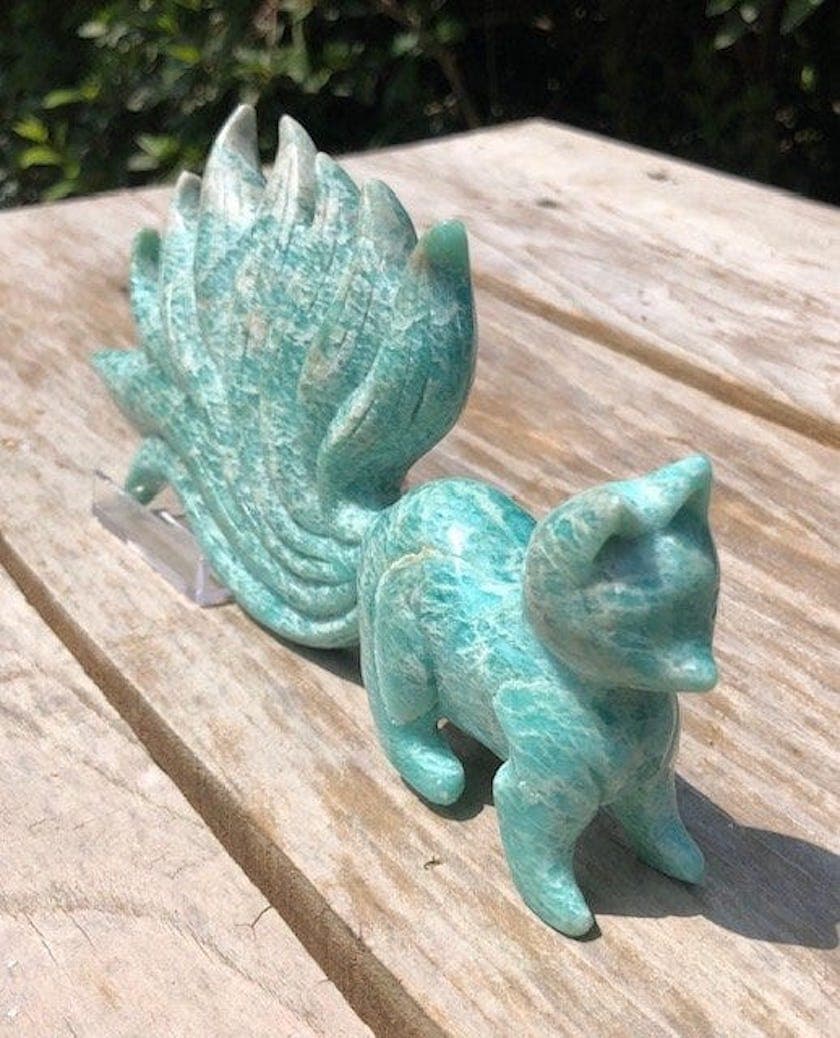Amazonite Value, Price, and Jewelry Information
A green to blue-green variety of microcline, amazonite makes a wonderful gemstone for cabbing and carving.
3 Minute Read
A green to blue-green variety of microcline, amazonite makes a wonderful gemstone for cabbing and carving.
Start an IGS Membership today
for full access to our price guide (updated monthly).Amazonite Value
What is Amazonite?
Also called "Amazon stone," amazonite is the only microcline you're likely to encounter as a gemstone. Microclines are potassium feldspars with a triclinic crystal structure.
Amazonite color can range from pale green to dark green and blue-green. These specimens usually (but not always) show white mottling.
Does Amazonite Make a Good Jewelry Stone?
By 5,200 BCE, cultures in Northern Africa, Mesopotamia, and the Indus Valley had begun cutting amazonites. Lapidaries all over the world have fashioned this gemstone into cabochons, beads, and carvings for millennia.
With a hardness of 6 to 6.5, amazonites are softer than other common jewelry stones, like quartz and beryls. This means amazonites are still susceptible to scratching from everyday hazards, like household dust (which has a hardness of 7). With perfect cleavage, amazonites may also break if accidentally struck.
However, these gems will still make excellent jewelry stones for earrings, pendants, and brooches, which usually don't receive rough wear. With protective settings, they can also make beautiful ring stones.
Amazonites lack transparency, so they're seldom faceted. Nevertheless, aficionados of opaque gems might appreciate the appearance and novelty of such a piece.
Are There Synthetic Amazonites?
Scientists have synthesized microcline feldspars for research purposes. However, there are few scholarly references to synthetic or lab-created microcline, and there's no indication amazonites are specifically created or that any of this material makes its way into jewelry use. Furthermore, feldspars are very common, and amazonite isn't too well-known as a jewelry stone. Thus, it's unlikely any great consumer demand exists for lab-created amazonites.
Despite this, you can easily find "synthetic amazonite" for sale online. Nevertheless, it's not clear if these stones are actually lab-created or just lookalike materials. These may be instances of the term "synthetic" being used in the popular sense of "not real."
Amazonite Treatments
Mined amazonites may also receive a number of treatments, such as impregnation (to conceal fracture inclusions) and coatings and dyes (to improve color). With irradiation, white microcline specimens may also turn into blue-green amazonites. This is a rare but stable treatment.
Some people may consider treated gemstones, even natural stones, to be "not natural." Those so-called "synthetic amazonites" offered for sale may just be treated, natural amazonites.
Is Amazonite a Jade?
Amazonite isn't an expensive gemstone. On the other hand, jade is very popular and can command high prices. Vendors may market amazonite as "Amazon jade," since some green specimens may resemble jade and consumers may assume it's a variety of that famous material. Some may be willing to pay more for a supposed jade, too.
Of course, feldspar, jadeite, and nephrite are distinct gem species. Gemologists can easily distinguish these gemstones. "Amazon jade" is a misleading name. If you encounter "Amazon jade" for sale, buyer beware.
Consult our list of false or misleading gem names for more examples.
Is Amazonite Found in the Amazon?
Amazonite has been associated with the Amazon, by name, since 1701, and possibly earlier. The noted mineralogist August Breithaupt officially named the stone "amazonite" in 1847, after an unspecified type locality near the Amazon River.
Although amazonite does occur in Brazil (in the states ofMinas Gerais, Paraíba, and Rio Grande do Norte) and Peru (in Huancavelica province), there are no known sources of this mineral within the Amazon rainforest itself or near the eponymous river.
Where is Amazonite Found?
Brazil and Peru produce fine amazonites, but this gemstone also occurs in many localities across the world.
In the United States, the area around Pike's Peak, Colorado and Amelia Courthouse, Virginia produce beautiful, gem-quality amazonites.
Ethiopia has also emerged as a producer of top-quality amazonite.
Other notable gem-quality sources include the following:
- Canada; China; Madagascar, Mozambique; Myanmar; Pakistan; Russia.
Stones Sizes
Hobbyists can usually buy amazonite rough by the pound. Consumers can find cabochons in almost any size.
How to Care for Your Amazonites
Untreated amazonites may have internal fractures, which can expand if subjected to mechanical cleaning systems, like steam or ultrasound. Treated stones may also lose their coatings and/or fillers through these processes. Instead, clean these gems with a soft brush, mild detergent, and warm water. Consult our gemstone jewelry cleaning guide for more care recommendations.
Joel E. Arem, Ph.D., FGA
Dr. Joel E. Arem has more than 60 years of experience in the world of gems and minerals. After obtaining his Ph.D. in Mineralogy from Harvard University, he has published numerous books that are still among the most widely used references and guidebooks on crystals, gems and minerals in the world.
Co-founder and President of numerous organizations, Dr. Arem has enjoyed a lifelong career in mineralogy and gemology. He has been a Smithsonian scientist and Curator, a consultant to many well-known companies and institutions, and a prolific author and speaker. Although his main activities have been as a gem cutter and dealer, his focus has always been education.
International Gem Society
Related Articles
Microcline Value, Price, and Jewelry Information
A Visitor’s Guide to Colorado Gemstones
Top Spots for Gem Hunting in the US
Demantoid Garnet Value, Price, and Jewelry Information
Never Stop Learning
When you join the IGS community, you get trusted diamond & gemstone information when you need it.
Get Gemology Insights
Get started with the International Gem Society’s free guide to gemstone identification. Join our weekly newsletter & get a free copy of the Gem ID Checklist!
